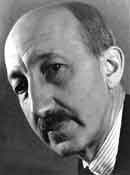George Charles de Hevesy
(1885-1966)

George Charles von Hevesy, also known as George Charles de Hevesy, was born on August 1, 1885, in Budapest, Austria-Hungary (now Hungary). Hevesy attended college at the Technische Hochschule in Berlin and the University of Freiburg. He began his work in chemistry in 1911 at the University of Manchester under Ernest Rutherford, which stimulated him to experiment with isotopic tracers. In 1912, Hevesy moved to Vienna, Austria to collaborate with Friedrich Paneth.
In 1923, Hevesy was a co-discoverer with Dirk Coster of the chemical element hafnium. He became a professor at the University of Freiburg in 1926 where he determined the comparative quantity of chemical elements. In 1934, Hevesy began to trace a radioactive isotope of phosphorus through the human body to study chemical processes.
After fleeing from the Nazis in 1943, Hevesy was awarded the Nobel Prize for Chemistry for his work with radioactive isotopes. Hevesy was the pioneer in scrutinizing the biochemical courses in living bodies by introducing radioactive isotopes or isotopic tracers. This process became know as the tracer method and sophisticated the world’s knowledge of chemical sequences that take place in life cycles.
Hevesy became a professor at the Institute of organic chemistry in Stockholm in 1943. After World War II, Hevesy returned to Germany to continue his research. In 1962, he published his findings in the two-volume Adventures in Radioisotope Research.
Hevesy died on July 5, 1966, in Freiburg im Breisgau, West Germany, at the age of 80.
Sources: Wikipedia; Britannica; Wigoder, Geoffrey, Ed. The New Standard Jewish Encyclopedia. NY: Facts on File, 1992 . Photo courtesy of ANTIQUARIAT KLAUS HILLE / BERLIN


